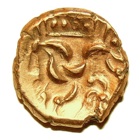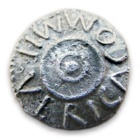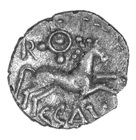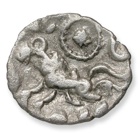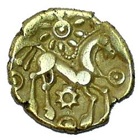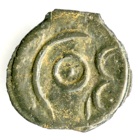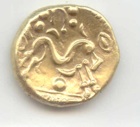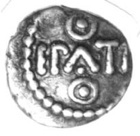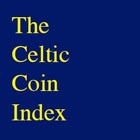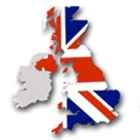
The Celtic coins can be tricky at the best of times, however, spinks can often point you generally towards the tribe / ruler that may have issued the coin.
THE CELTIC COIN INDEX
There are a few sites and tricks for looking at celtic coins, and TWO sites known as the Celtic Coin Index.
The OLD SITE has fewer search options, but larger thumbnail images for assisting when you are looking for a visual ID, the NEW SITE has much more search options, but small images so can be more useful when you have certain information to hand.
The old site can be very good for scrolling through coins if you only know the metal type, or the tribe for example, it may take you a while to find a close match, but you get better with time.
As your search narrows, and you are aware of the celtic coin reference number as listed by Van Ardsell, the new site can be very useful using THIS LINK as you can replace the four digit VA number in the address bar with your number to view the coins in that group. you must remember however to follow the number with .01 as seen in the address bar. The spinks book lists a lot of celtic coins in groups, a coin that seems like the one you are researching may have several VA numbers after it, the link above will quickly allow you to see the coins in the group as defined by Spinks.
An example of this would be the Whaddon Chase Gold Stater, spink 32, this coin has the following ‘V’ numbers 1470-6; 1485/7/9/93 This means you would replace the 1470.01 at the end of your link in the address bar with 1472.01 or 1474.01 or 1476.01 and so on with the 1485 numbers.
CHRIS RUDD’S CELTIC COIN SITE
Chris Rudd’s CELTIC COIN SITE is a major resource for further information as long as you know how to access it effectively. his pdf sale catalogues are a great source of information so you should download these monthly and read them, but the power of search engines can be your greatest allie provided you know its tricks.
USING GOOGLE
Google can be directed to search for specific terms as well as general words, and can be also directed to search a site of your choice alone. If you wished to search for a CANTERBURY DRAGON celtic coin and types that into google you would get about 800,000 hits return to you, if you put “quote marks” on either end of the words “CANTERBURY DRAGON” you get 380 results, as google searchs for those words in that order, and next to each other.
If you wish to just search Chris Rudd’s site and any pdf’s stored on his site for the term type the following into the google search window
“canterbury dragon” site:www.celticcoins.com
you get about 3 hits returned to you and they are correct, if you did not know it was a Canterbury Dragon, but thought to yourself, “it looks like a dragon” then you can type the following
dragon site:www.celticcoins.com
you get about 7 returned hits and your coin may just be amongst them, and you know have knowledge about some celtic coins with dragons on, and also may have now got more information about your coin type as compiled by Chris Rudd, and maybe the Van Ardsell number, as seen below
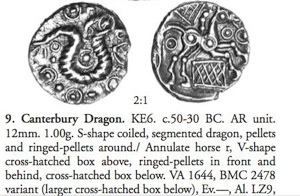
Celtic Tribes
Struck Celtic coins are instantly recognisable by their concavo-convex (dished) flans, although Potins and some bronze issues were cast in moulds and are flat. If you find a Celtic coin, chances are very good that it will have been issued by the tribe who’s territory encompassed the find spot. However, it is not unusual to find coins of the neighbouring tribes, and large numbers of (mostly gold) coins were imported from the continent during this period. The map below shows the Ancient British tribal areas.
This link will take you to the coin pages of the old Celtic Coin Index, where you can view coins by geographical area. Click an area of the country, and the relevant tribe(s) will be shown below it. Click on the name of the tribe and you will be shown images of all the coin types of that particular tribe. Coins are shown in the order they appear in Celtic Coinage of Britain By Robert Van Arsdell and are listed by VA number. Coins not covered in VA are listed under ‘No VA Number’
Denominations
Recognising the denomination can play a vital role identifying a Celtic coin correctly, as very similar designs were used on coins of different metals and denominations. The usual denominations/metal types of British Celtic coins are given below along with typical diameter and weight range
GOLD

STATER
16-20mm / 5.0-6.5g
QUARTER STATER
10-14mm / 1.0-1.5g

SILVER
HALF UNIT
9-12mm / 0.4-0.6g
MINIM
7-9mm / 0.2-0.3g
UNIT
12-16mm / 0.9-1.4g



DUROTRIGES ONLY
SILVER STATER
17-19mm / 4.0-5.0g
QUARTER STATER
11-13mm / 0.9-1.2g


BRONZE
UNIT
13-18mm / 1.0-3.0g

Potin (High Tin content Bronze)
These coins usually display casting sprues, caused by casting the coins in strips and then snapping off individual coins. The diameter of Potins varies between 13 - 19mm (excluding the sprues) and weight varies greatly depending on type. They can weigh anything from 1.2g to over 7.0g.
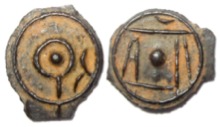
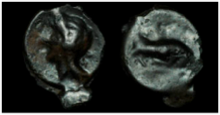

If you already know your tribe, click the tribe image below to access a visual guide for coins of that tribe listed by Van Ardsell reference number, this search can also be a good way to navigate celtic coins as it shows one of each coin.
ATREBATES
CANTII
CORIELTAVI
DOBUNNI
DUROTRIGES
UNCERTAIN BRITISH
ICENI
CATUVELLAUNI
TRINOVANTES
ATREBATES - No VA
CANTII - No VA
CORIELTAVI - No VA
DOBUNNI - No VA
DUROTRIGES - No VA
UNCERTAIN - No VA
ICENI - No VA
CATUVELLAUNI
TRINOVANTES - No VA
Common searched by other terms

GOLD
SILVER
UNITS
HALF UNITS
QUARTER STATER
BRONZE
CONTINENTAL
MINIM
Celtic Coin Search Engine Sites

Old CCI
Oxford CCI
UKDFD
CHRIS RUDD
















